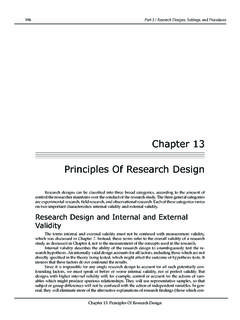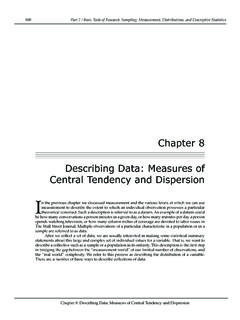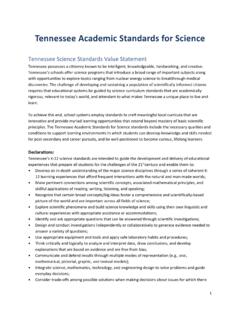Transcription of Chapter 18 Research Procedures - CIOS
1 274 Part 3 / Research Designs, Settings, and ProceduresChapter 18: Research ProceduresChapter 18 Research ProceduresIn this Chapter we ll discuss the major methods for measuring variables and collecting data to testhypotheses. We will present a brief introduction to the mechanics of these major Procedures andwe will also discuss them in terms of the advantages and disadvantages they offer to the re-searcher. There are any number of books devoted to presenting the intricacies of interviewing, ques-tionnaire construction, unobtrusive measurement, etc. The serious communication researcher shouldrefer to these sources to get more complete information about techniques, advantages, and pitfallsof the particular Research Procedures that are required by her Research . Furthermore, as the mea-surement of communication data in many cases involves acquiring the cooperation of respondentsin varying degrees, we will discuss the ethical implications of selecting methods of gathering TechniquesBehavioral ObservationMuch of the measurement of communication variables falls in the category of behavioral ob-servation.
2 With this technique, a trained person observes a specific set of behaviors exhibited by aresearch subject and uses trained judgment to assign the correct values to the appropriate instance, in the Bandura et al. experiment described in Chapter 14, if the observer sees achild from the experimental group carry out an act of physical or verbal aggression identical to thatoriginally exhibited by the adult model, the child s act is counted in the category Imitative Aggres-sion , and not in the category called Partially Imitative Aggression . In the Leavitt study described275 Part 3 / Research Designs, Settings, and ProceduresChapter 18: Research Proceduresin the same Chapter , the observer starts a clock at the beginning of a trial, and stops the clock once allgroup members have thrown their switches. The number of seconds needed for completion is thevalue assigned to the variable Time Elapsed for that group s both studies the observer determines the level of the variable.
3 Because a human observer isinvolved, there can be large differences in the reliability of measurement. Reliability often variesaccording to the complexity ordifficulty of the judgment required by the measurement task. The instructions issued to theobserver in the Leavitt study might have read something like this: Start the clock and give the signal to start the trial. Stop the clock when all five lights have been illumi-nated. Read the clock s elapsed time and enter the number on line 5 of the coding sheet. Reset the clock. This kind of behavioral observation is likely to yield highly reliable measurement. First of all,the same observer should obtain very similar results if he repeats the same task repeatedly underthe same conditions. This is test-retest reliability. Second, given the simplicity and straightforward-ness of the instructions, several different observers of the same trial should show very high levels ofagreement on the amount of elapsed time.
4 Such agreement is referred to as intercoder,interexperimenter or interjudge greater ambiguity associated with the decision making process in the Bandura study willprobably result in lower levels of test-retest and intercoder reliability. For instance, the observermust decide to what extent a child must deviate from the model s behavior before the child s behav-ior is assigned to the category Partially Imitative Aggression rather than to the Imitative Aggres-sion category. If different observers evaluate the same behavior, there is likely to be some disagree-ment. If two different measuring instruments (the observers) give two different readings aboutthe phenomenon being measured, there is measurement in behavioral observation can be improved in two ways: (1) make the observationtask simple and concrete; and (2) give clear, extensive instructions and training to the observers.
5 Ifyou ask an observer to Count the number of nice remarks made by each person in the conversa-tion, you are going to get some widely different answers from different observers who hear thesame taped conversation, and even from the same observer who codes the same conversation at atwo-week interval. The instructions are too vague to produce reliable the other hand, if you ask the observer to Count the number of times each person com-mented favorably on the clothing of the other, and Count the number of times each person said thank you to the other, you will probably get reliable results. By combining a number of suchconcrete observational tasks, you can measure niceness with much more detail and reliabilitythan the first vague question could ever and Unobtrusive MeasurementBehavioral observation can be either obtrusive or unobtrusive measurement. This distinctionrefers to the extent to which the respondent or subject is aware that he or she is being evaluated.
6 Aswe saw in Chapters 13 and 17, this awareness can affect both the internal validity and externalvalidity of a study. Awareness can produce sensitization to the experimental manipulation, enhancedmemory effects, reactivity to the Research setting, and a host of other artificial effects which willobscure true is almost always the goal of a communication researcher to make observation as unobtrusiveas possible. This can be done with careful design of the Research setting or by choosing a measure-ment method that is inherently Obtrusiveness. Research settings can often be constructed so that the observer isinconspicuous or completely hidden. For example, in the Bandura study the children were observedthrough a one-way mirror which prevents the observed person from seeing the observer. The chil-dren may not have been aware of the purpose of a one-way mirror, but for older Research partici-pants the presence of a one-way mirror will be a dead give-away that they are being observed.
7 Thisrealization may affect behavior in unknown ways. But even if they realize that they are being ob-served from behind a mirror, there is a tendency to ignore the observer after a time, because thereare no movements or noises from the observer to remind the subject that she is being the subject suspects that he is being surreptitiously observed, he may actually react more276 Part 3 / Research Designs, Settings, and ProceduresChapter 18: Research Proceduresstrongly than if he is told that someone is behind the one-way mirror. The presence of a passivemirror or a small video camera in a discreet box are easily ignored after the novelty wears off, so itis often better to inform a subject that they are being observed that it is to allow them to have uncon-firmed suspicions. Even if it is impossible to completely hide the observer, the obtrusive effect canbe reduced by placing the observer in an out-of-the-way corner of the room and instructing him toremain as motionless and quiet as possible, to avoid rustling the coding sheets, is a privacy issue involved with unobtrusive measurement.
8 It boils down to this: shouldthe Research subject be informed that he is being observed, even if that information may affect hisbehavior during the Research ? We ll have more to say about this in the final section of this chapterwhen we discuss various ethical dilemmas in communication Unobtrusive Measurement. Some types of observational measurement are inher-ently unobtrusive. This data is collected with little or no awareness by the sources of the data thatcommunication Research is being example, state and federal governments routinely collect social data. The Govern-ment collects census data which describes the population in regions as large as the whole countryand as small as a few square miles. This data is often very useful for comparison with sample demo-graphic data, and for weighting or correcting sample data to make it more representative of thepopulation values.
9 Census data can also be used directly when the researcher uses a social systemunit of analysis like the neighborhood or region. For example, the mean income or number of tele-phones in urban census tracts could be useful variables for a telecommunications researcher. Commerce department also collects detailed data about business organizations that can beused for similar aggregate analysis purposes. Governmental data is available at many public librar-ies and at most university are also archives of individual-level data that are very useful as sources of unobtrusivecommunication data. Public opinion poll and marketing Research data are available from archiveslike the Institute for Social Research at the University of Michigan and the Roper Center for PublicOpinion Research at the University of Connecticut. These archives contain the data and summaryresults from tens of thousands of questions asked of millions of people.
10 They are particularly usefulfor overtime Research . Similar or identical poll questions taken from surveys conducted over a spanof years provides the communication researcher with a very valuable and inexpensive source ofover-time the mass communication researcher, these archives are particularly useful when their in-formation is combined with data from media archives which collect and preserve newspaper andmagazine stories, television newscasts, television and radio commercials, and other media mes-sages. Most large libraries carry the New York Times Index which can be used to summarize thefrequency that newspaper stories about selected issues or topics appear. The Vanderbilt TelevisionArchives publish an index of network television story coverage and can provide videotapes of sto-ries about selected topics. The researcher can use a media archive to provide the material for acontent analysis (described in more detail later in this Chapter ).



